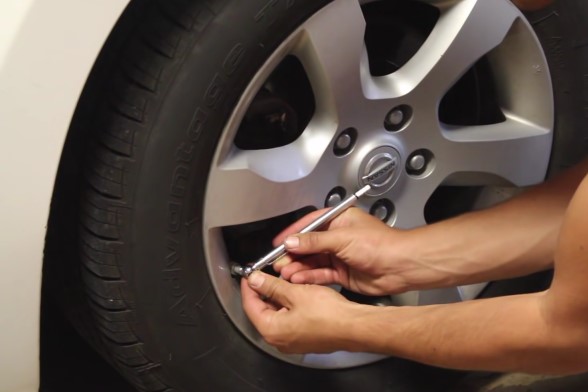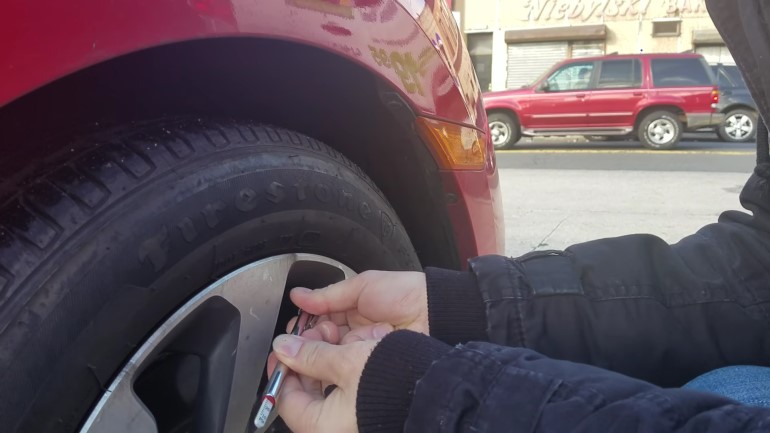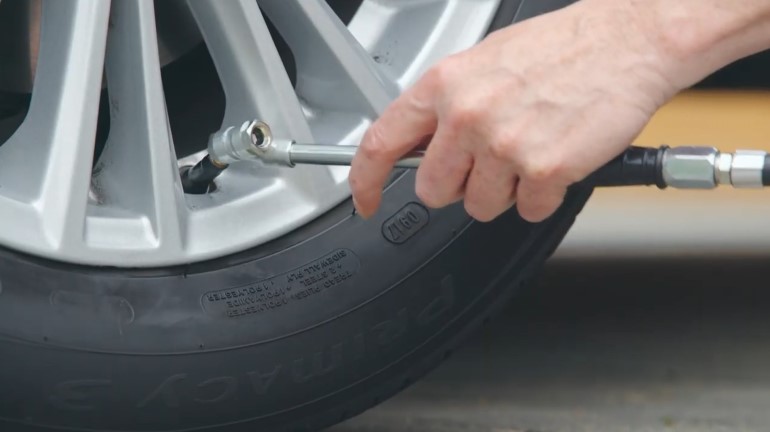What if you’re out on a long road trip and one of your tires goes flat? You might be thinking that it’s the end of the world, but with a spare tire and some knowledge on how to change a tire, you can fix the problem and be back on your way.
However, what if your spare tire is also flat? In this case, you need to know how to deal with low tire pressure. While it is not recommended to drive in a car with low tire pressure, there are cases where it is necessary.
If you’ve ever driven on a freeway in Southern California, you know that the heat can cause your tires to deflate quickly. And if you’re not careful, you could end up driving on tires that are too low. So what exactly is the minimum tire pressure you should be driving on?
The answer may surprise you. According to the U.S. Department of Transportation, the minimum tire pressure for passenger cars is 24 pounds per square inch (psi). That’s for cars that weigh less than 4,000 pounds. For heavier vehicles, the minimum tire pressure is 28 psi.
Of course, these are just the minimums. The recommended tire pressure for most passenger cars is between 32 and 35 psi. And for trucks and SUVs, it’s between 35 and 60 psi. So if you’re driving on tires that are anywhere near the minimum, you’re taking a risk.
Not only do low tires decrease your gasoline mileage, but they also make your car more difficult to handle. If you hit a pothole or a piece of debris in the road, you’re more likely to have a blowout. And that could be dangerous, not to mention expensive.
So what’s the moral of the story? Check your tire pressure regularly (at least once a month), and top off your tires if they start to get low. Your wallet will thank you, and so will your car.
This blog post will explore what those situations are and what you should do to make sure you’re driving safely.
Stay safe out there!
What Is the Lowest Tire Pressure You Can Have and Still Drive?

The lowest tire pressure you can have and still drive is 20 PSI. However, this is not recommended as it can lead to decreased fuel economy and increased wear and tear on your tires. Your tire pressure monitoring system (TPMS) warning light only comes on when your tire pressure is too low.
Generally, the light comes on when your tire’s air pressure is 25% below the recommendation. A drop in this level is quite severe. This means you will not be alerted of mild/moderate under-inflation of your tires. It is a good idea to have a tire pressure gauge in your vehicle. Although some gas station air pumps have gauges, they’re not always accurate or easy to reach.
It’s much better to have your own tire gauge so that you can keep an eye on tire pressure at home or on the road. You can easily buy an inexpensive, hand-held tire pressure gauge at any auto parts store or major department stores, like Target or Walmart.
It is best to keep your tires inflated to the manufacturer’s recommended pressure, which can be found on the placard inside your car door.
Why Is It Important to Check Tire Pressure?
It is important to check your tire pressure for a few reasons. First, underinflated tires can lead to decreased fuel economy. Second, underinflated tires can wear out more quickly and cause premature tread wear. Third, underinflated tires can increase the risk of a blowout or other tire failure.
inflated tires can lower your gas mileage by about 0.2% for every 1 PSI drop in average pressure. While that might not seem like a lot at first, let’s assume your tires are underinflated by about 12 psi, which is very common.
Assuming you drive the nationwide average of 13,476 miles a year, you’re underinflated tires are wasting roughly a full tank of gas each year. But that isn’t all. Underinflation causes tires to distort, leading to increased wear, especially on the sidewalls of the tires, putting your tires at an increased risk of having a blowout — something no one wants to experience.
What Are the Signs of Low Tire Pressure?
There are a few signs that you may have low tire pressure.
First, you may notice that your car is riding rough. Second, you may hear a thumping noise coming from your tires. Third, you may see that your tires are bulging or have cracks in the sidewalls.
If you notice any of these signs, it is important to check your tire pressure and inflate your tires as needed. Checking tire pressure about two times per month can ensure that premature tire wear, increased braking distances, inadequate steering, and accidents are avoided because of low tire pressures.
Shawn Furman, I have been a vehicle hobbyist for as long as I can remember as well as a freelance writer for the past three and a half years. My clients have included Vehicle Scene, Autolist, CarGurus, and now The Vehicle Lab.
Poor Fuel Economy
Underinflated tires can lead to decreased fuel economy. This is because underinflated tires have more rolling resistance, which means they take more energy to keep them moving. It also means you must always replace tires with the same wheel they came off. In short, yes. TPMS does help by informing you of any sudden changes in tire pressures.
However, indirect TPMS often thinks there’s a puncture when there isn’t. Considered Low Tire Pressure as with many things, the answer is relatively simple. Consult your owner’s manual, and don’t settle for anything less (or more) than it says.
By keeping your tires at the correct pressures – not too low and not too high – you’ll have much-improved gas mileage. To calculate the cost of this decreased fuel economy, use this calculator from the U.S. Department of Energy.
Tire Wear
Underinflated tires can also wear out more quickly and cause premature tread wear. This is because the contact patch (the area of the tire that touches the ground) is smaller on an underinflated tire.
As a result, it takes more engine power to travel at the same speed or accelerate at the same rate. Because of this, your fuel economy will quickly plummet, especially if multiple tires are significantly low. Increased Tire Wear Tires with low pressure will wear out much quicker than properly inflated tires.
This happens for the same reason: too much tire is “dragging” along the road. It’s literally being stretched and manipulated as it rolls over the asphalt surface. Watch for wear on both the inside and outside of the tire. This causes the tire to flex more, which generates heat and can lead to tread separations.
Stopping Distance
Another reason to keep your tires inflated is that underinflated tires can increase the stopping distance. This is because the contact patch is smaller on an underinflated tire, which means there is less traction.
In a panic stop, you need all the traction you can get to avoid an accident. you need to understand the speed you should go with under-inflated tires and other tips and tricks to make the ordeal as safe as possible. When driving on low tire pressure, you risk a flat tire, which could result in a terrible accident.
So, the fastest you should drive without tires properly inflated is 50 miles per hour. Any faster, and you’re putting yourself at risk. Please bear in mind that this is the maximum limit!
We always recommend driving as slowly as possible with low air pressure in your car’s tires
What Causes Tire Pressure to Become Low?

There are a few reasons why your tire pressure may become low.
First, the temperature can cause tire pressure to change. Cold weather can cause tire pressure to decrease, while hot weather can cause it to increase. Second, a slow leak in the tire can lead to decreased pressure over time. Ignoring low tire pressure causes issues with handling, fuel economy, tire wear, and safety on the freeway!
If it’s been a while since you’ve last checked, or if temperatures have dropped, fill those tires – now! Reading Time: 5 minutes Why You Shouldn’t Rely On Your Low Tire Pressure Warning Light (TPMS) Similar to your low-fuel warning light, your tire pressure monitoring system (TPMS) warning light only comes on when your tire pressure is too low.
Generally, the light comes on when your tire’s air pressure is 25% below the recommendation. A drop in this level is quite severe. Third, driving on rough roads can cause the tires to lose some air. Finally, if you hit a curb or pothole, it can damage the tire and cause it to leak air.
What Happens When Tire Pressure Is Too Low?
If you drive on tires that are too low, you may notice decreased fuel economy and increased tire wear. You may also find that your car is riding rough or that you hear a thumping noise from the tires.
Keeping them topped up with air will save you from the potential signs and consequences listed below. You can check your tires for obvious pressure losses by simply looking at them and pushing the sides with your thumb. If you feel significant give, they’re too low. Have a tire pressure gauge in your car at all times so you can check the pressures and know for sure whether they’re too high or too low.
When a tire’s pressure is too low, the surface area in contact with the road will drastically increase. The rubber essentially sticks to the road. In addition, underinflated tires can increase the risk of a blowout or other tire failure. If you have low tire pressure, it is important to inflate your tires as soon as possible.
Final Thoughts
So, the next time you’re questioning what tire pressure is too low to drive on, consider your car type and the weather conditions. For example, if it’s a hot day, your tires will be softer and you’ll want to add air accordingly.
Tire pressure becomes too low when it drops below the manufacturer’s recommended inflated value, often found on a sticker on the driver’s side doorjamb of a vehicle. The pressure is measured in pounds per square inch, and tire pressure monitoring systems usually alert the driver to pressures that drop about ten to twenty-five percent below recommended value – usually around 35 PSI.
If you have a heavier vehicle, like an SUV, you’ll also want to make sure your tires are properly inflated. By following these tips, you can avoid getting a flat tire or worse while out on the road.
Do you have any other tips for making sure your tires are at the proper pressure?
Let us know in the comments below!


